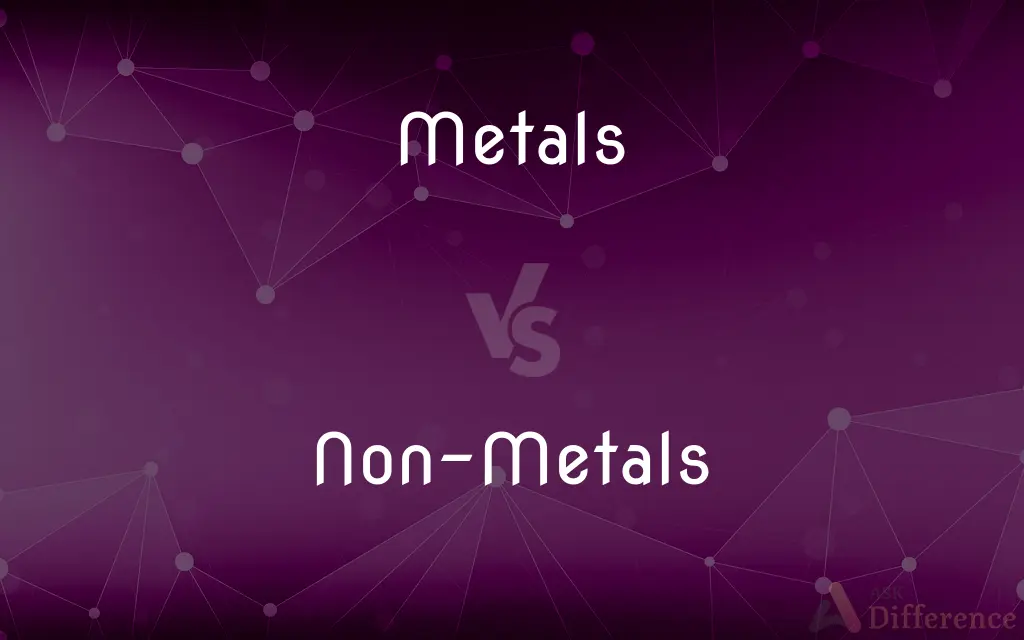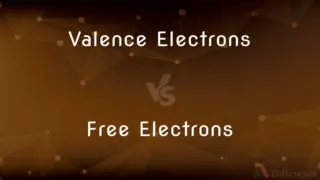Metals vs. Non-Metals — What's the Difference?
By Tayyaba Rehman — Published on November 12, 2023
Metals are shiny, malleable substances that conduct electricity; non-metals are diverse elements often lacking metal characteristics.

Difference Between Metals and Non-Metals
Table of Contents
ADVERTISEMENT
Key Differences
Metals are elements found on the left side of the periodic table and are generally characterized by their luster and ability to conduct electricity. Non-metals, on the other hand, are elements located on the right side of the periodic table, often exhibiting insulating properties.
Metals tend to have a high melting point and are typically solid at room temperature, with the exception of mercury. Non-metals have varied physical states, including gases like oxygen and solids like carbon.
Metals are usually malleable and ductile, meaning they can be reshaped without breaking. Non-metals lack these properties and are often brittle in their solid form.
Most metals are good conductors of heat, making them essential in many industries. Non-metals, however, generally have poor heat conduction capabilities, making them useful as insulators.
Electronically, metals often lose electrons to form cations, while non-metals typically gain electrons, forming anions. This fundamental difference leads to their respective roles in forming ionic compounds.
ADVERTISEMENT
Comparison Chart
Physical State
Usually solid (except mercury)
Varies (solid, liquid, gas)
Electrical Conductivity
Good conductors
Poor conductors or insulators
Malleability/Ductility
Malleable and ductile
Brittle (when solid)
Electron Behavior
Tend to lose electrons (form cations)
Tend to gain electrons (form anions)
Heat Conductivity
Good conductors
Generally poor conductors
Compare with Definitions
Metals
Malleable substances that can be reshaped.
Metals like aluminum can be rolled into sheets.
Non-Metals
Typically poor conductors of electricity.
Rubber, a non-metal, is used as an insulator in electrical wires.
Metals
Good conductors of heat.
Metals like copper are used in cooking pans due to their heat conductivity.
Non-Metals
Elements that form negative ions (anions).
Chlorine, a non-metal, gains an electron to become negatively charged.
Metals
Elements with luster and electrical conductivity.
Gold and silver are precious metals.
Non-Metals
Can be brittle in solid form.
Sulfur, a solid non-metal, is brittle and can be crushed into powder.
Metals
Typically solid at room temperature.
With the exception of mercury, most metals are solid.
Non-Metals
Often used as insulators due to poor heat conductivity.
Glass, a non-metal, is used in windows because it doesn't conduct heat well.
Metals
Any of a category of electropositive elements that usually have a shiny surface, are generally good conductors of heat and electricity, and can be melted or fused, hammered into thin sheets, or drawn into wires. Typical metals form salts with nonmetals, basic oxides with oxygen, and alloys with one another.
Non-Metals
Elements with varied physical states and properties.
Oxygen and nitrogen are non-metals that make up our atmosphere.
Metals
An alloy of two or more metallic elements.
Non-Metals
Plural of non-metal
Metals
An object made of metal.
Metals
Basic character; mettle.
Metals
Broken stones used for road surfaces or railroad beds.
Metals
Molten glass, especially when used in glassmaking.
Metals
Molten cast iron.
Metals
(Printing) Type made of metal.
Metals
(Music) Heavy metal.
Metals
To cover or surface (a roadbed, for example) with broken stones.
Metals
Plural of metal
Metals
(rail transport) the rail tracks owned by a company or organisation; a rail network
It was appropriate that 'King' number 6000 began the return to steam on British Rail metals in 1971.
Metals
Elements that form positive ions (cations).
Sodium, a metal, loses an electron to become positively charged.
Common Curiosities
Are all non-metals gases?
No, non-metals can be gases, liquids, or solids.
Where are metals generally located on the periodic table?
Metals are generally found on the left side of the periodic table.
Which metal is liquid at room temperature?
Mercury is the only metal that is liquid at room temperature.
What happens when metals react with non-metals?
Metals tend to lose electrons to non-metals, forming ionic compounds.
Which non-metal is essential for breathing?
Oxygen is a non-metal essential for respiration.
How do non-metals typically bond?
Non-metals usually bond covalently with other non-metals.
Are all metals heavy?
No, some metals like aluminum are lightweight.
Can non-metals conduct electricity?
Most non-metals are insulators, but there are exceptions like graphite.
Why are metals often used in wiring?
Metals are used because they are good conductors of electricity.
Why are metals malleable?
The atomic structure of metals allows layers of atoms to slide over each other.
Can non-metals be shiny?
Typically, non-metals are not shiny, but there are exceptions like iodine.
Are metals typically reactive?
Many metals are reactive, like sodium, but some, like gold, are unreactive.
Are metals naturally found pure in nature?
Some metals are found pure, but many are found as ores and need processing.
Do non-metals have a metallic luster?
Generally, non-metals do not have a metallic luster, though there are exceptions.
What makes metals good conductors of heat?
The free-moving electrons in metals enable them to conduct heat efficiently.
Share Your Discovery

Previous Comparison
UK English vs. US English
Next Comparison
Valence Electrons vs. Free ElectronsAuthor Spotlight
Written by
Tayyaba RehmanTayyaba Rehman is a distinguished writer, currently serving as a primary contributor to askdifference.com. As a researcher in semantics and etymology, Tayyaba's passion for the complexity of languages and their distinctions has found a perfect home on the platform. Tayyaba delves into the intricacies of language, distinguishing between commonly confused words and phrases, thereby providing clarity for readers worldwide.
















































